Art & Exhibitions
David Ebony’s Top 10 New York Gallery Shows for November
Sweep away your post-election blues.
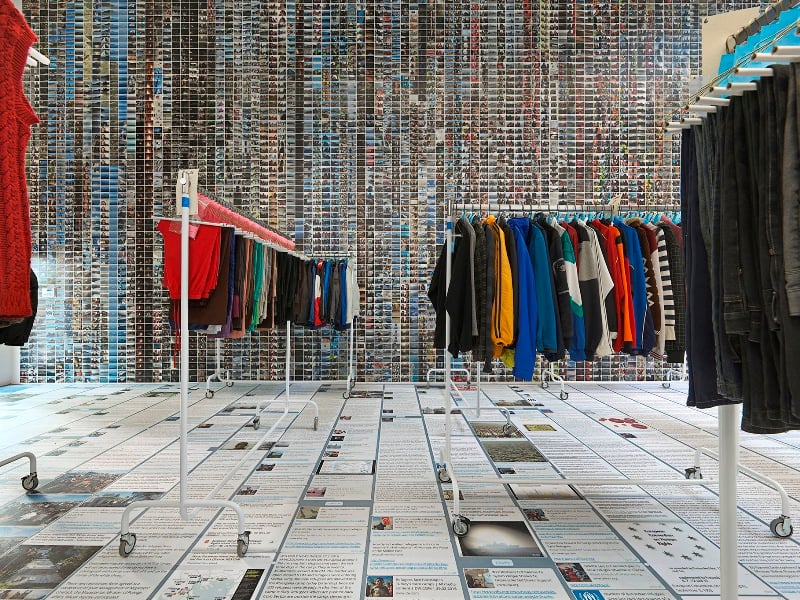
Sweep away your post-election blues.

David Ebony

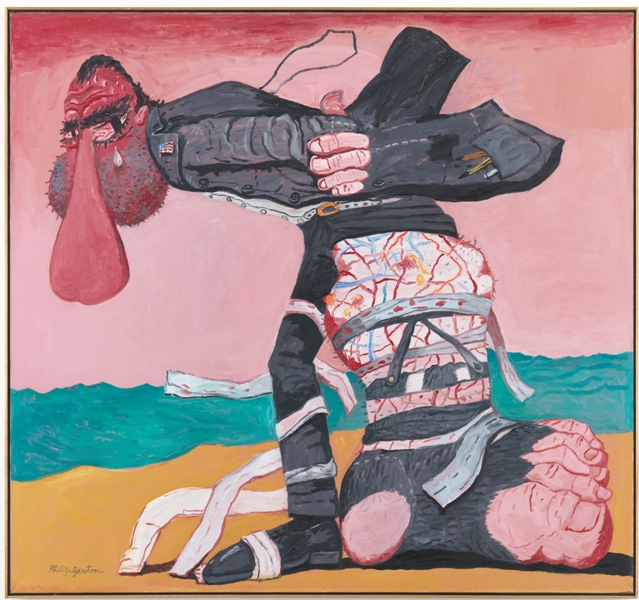
Philip Guston, San Clemente, 1975.
© The Estate of Philip Guston; Photo Courtesy Hauser & Wirth.
1. Philip Guston at Hauser & Wirth, through January 14, 2017.
In light of the imminent change of government in Washington D.C., in which the conservative right wing assumes control of the White House as well as Congress, it seems that artists, as they have often done over the years, are bound to play key roles in shaping the opposition. “Philip Guston: Laughter in the Dark, Drawings from 1971 & 1975” is a stunning example from America’s relatively recent past. The exhibition, inaugurating Hauser & Wirth’s newest Chelsea venue, could not be more timely or poignant. It offers an in-depth examination of the artist’s scathing and frequently humorous depictions of disgraced president Richard M. Nixon, created during one of the most tumultuous periods in U.S. history. In these works, Guston conveys the cautionary tale of a public figure who rose to the greatest heights of political power by means of lies and deception.
On view are some 180 drawings, many of which have never been shown before, plus three major, rarely exhibited paintings that center on works that Philip Guston (1913-1980) produced late in his career. At the time, Guston, who had established a solid reputation as one of the country’s leading abstract painters, was himself revolting against an art world that had misunderstood and shunned the figurative paintings he introduced in the late 1960s. Today, these works are regarded as vitally important as they heralded the art world’s return to figuration in the 1980s.
In a brash and acerbic style that recalls R. Crumb cartoons as well as the satirical drawings of Hogarth, Daumier, and Goya, Guston churned out dozens of images exploring the life and times of Nixon and his cronies like vice president Spiro T. Agnew, John Mitchell, and Henry Kissinger. Through these drawings, which were intended as a book, Guston presents, among many themes, a scathing indictment of Nixon’s self-mythologizing, as in his much-hyped visit to China. Guston saw the visit as a hypocritical gesture since Nixon had escalated the Vietnam War, and built his career partly by demonizing communists. Guston returned to the subject in 1975 after Nixon, facing impeachment, had resigned the presidency and retired to San Clemente, California, to try in vain to repair his forever-demolished legacy. Guston’s large, arresting painting from 1975, San Clemente, shows the red-faced Nixon on the beach, with his huge, phlebitis-swollen leg, and a tear of self-pity in his eye.

Installation view, Ai Weiwei, “Laundromat,”2016.
Photo Courtesy Jeffrey Deitch Gallery.
2. Ai Weiwei at Mary Boone, Jeffrey Deitch, and Lisson galleries, through December 23.
For the past twenty years or more, Chinese artist Ai Weiwei has been a major voice of opposition, creating works with an international outlook and on an enormous scale. Decrying inequality and oppression, Ai has made an impact in his homeland and around the world in recent years despite the fact that he was detained in China by authorities from 2011 through July 2015, when his passport was returned. Since then his output has been even more prodigious than before. The organization and operation of his studio must resemble that of a small country. It takes four major New York venues, for instance, to contain just some of his most recent projects. Encompassing a diverse group of sculptures, installations, photo works and video, all of the presentations on view are visually engaging and thematically compelling.
At Lisson and Mary Boone galleries in Chelsea, Ai presents life-size tree trunks and tree roots made of cast iron. The monumental Tree at Boone is a composite, cast from various tree fragments gathered from the mountains of Southern China. The works are convincing realist sculptures, and generally appealing as such, but by rendering fragile organic matter in rusting metal, Ai makes a wry statement about the increasingly dire conflict between nature and industrialization. Mary Boone’s midtown space features on the floor surrounding a pillar a circular assemblage of 40,000 broken teapot spouts. From a distance they appear as ceramic fingers, a motif which is echoed in the wallpaper design, which features a repeated image of the quintessential protest gesture—an extended middle figure.
The most emotionally wrenching of the presentations, Laundromat, on view at Jeffrey Deitch in SoHo, directly addresses the Syrian refugee crisis galvanizing Western Europe and the world. For this inspired and devastating work, Ai visited refugee camps in Greece along the Macedonian border. As police dispersed the crowds the refugees left behind tons of clothing and apparel that Ai’s assistants brought back to his Berlin studio, cleaned, pressed, and reassembled for the centerpiece of this installation. Countless photos lining the walls and a video document the project. Filling the space, laundromat- or thriftshop-style racks of clothing and rows of shoes are affecting and disturbing as they evoke the masses of desperate and traumatized individuals with no place to call home.
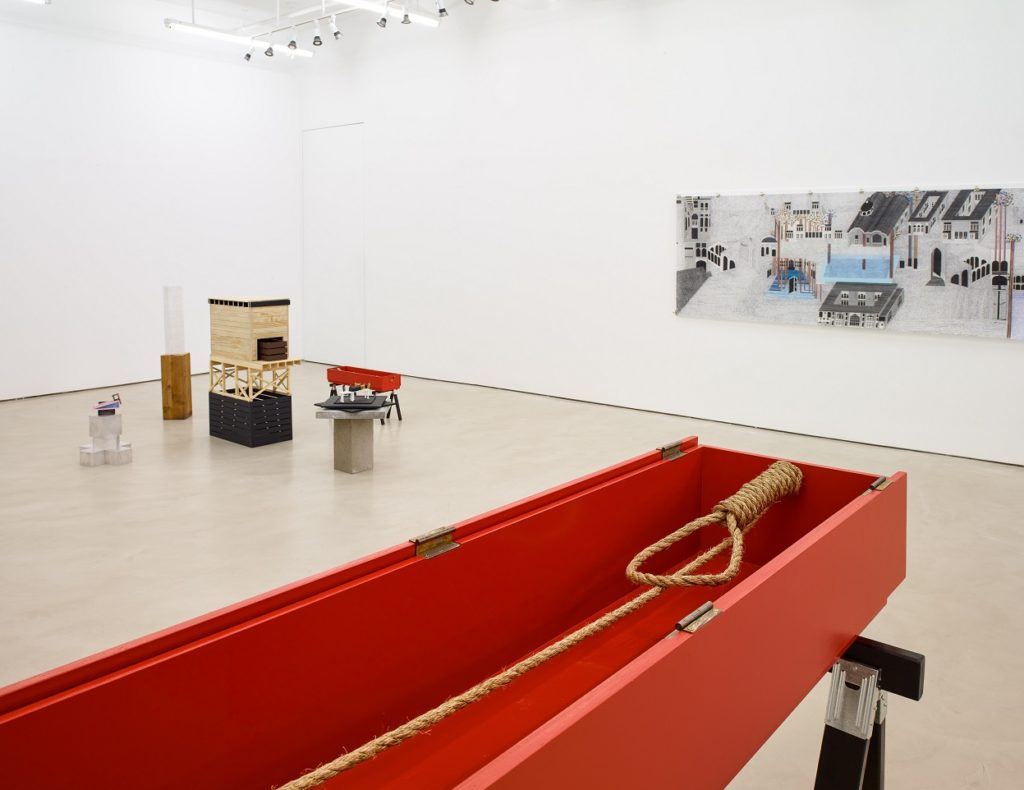
Installation view, Siah Armajani, showing, in foreground, Tomb for Dietrich Bonhoeffer, 2016.
Photo Courtesy Alexander Gray Associates.
3. Siah Armajani at Alexander Gray Associates, through December 17.
Viewing Siah Armajani’s exhibition of recent works a few days after the election perfectly suited my reflective mood. Most of the pieces on view are new additions to the Iranian-born, Minnesota-based artist’s ongoing “Tomb Series” of sculptures, drawings, and installations commemorating martyrs, activists, artists and writers. Previous works included Tomb for Sacco and Vanzetti (2009), and “tombs” for writers Walt Whitman, and Theodor Adorno. The new group features imaginative crypts for the late poets Frank O’Hara and Arthur Rimbaud, and the philosopher Richard Rorty, who died in 2007.
Outstanding among the new pieces is Tomb for Dietrich Bonhoeffer (2016), a tribute to the German writer and outspoken critic of the Nazi party, who was imprisoned in 1943, and executed in the Flossenbürg concentration camp two weeks before Allies liberated the place. It is an uncanny, coffin-like wood object painted bright red, and mounted on two saw horses, with lateral doors opened to reveal a noose, the manner of Bonhoeffer’s death.
Despite the subject matter, the overall tone of the exhibition is hopeful rather than morbid. I went through the show with painter Elliott Green, who focused on Armajani’s vast (40 by 223 inches), panoramic ink drawing on paper, Written Iran (2015-2016), pointing out the consistently eccentric perspectives in the details of Persian architecture throughout the composition. In this meticulous line drawing, the urban scene, referencing landmark buildings in Isfahan, interspersed with dense passages of classic Persian poems rendered in calligraphy by the artist’s hand, is part of a personal vision, arcane and somehow futuristic.
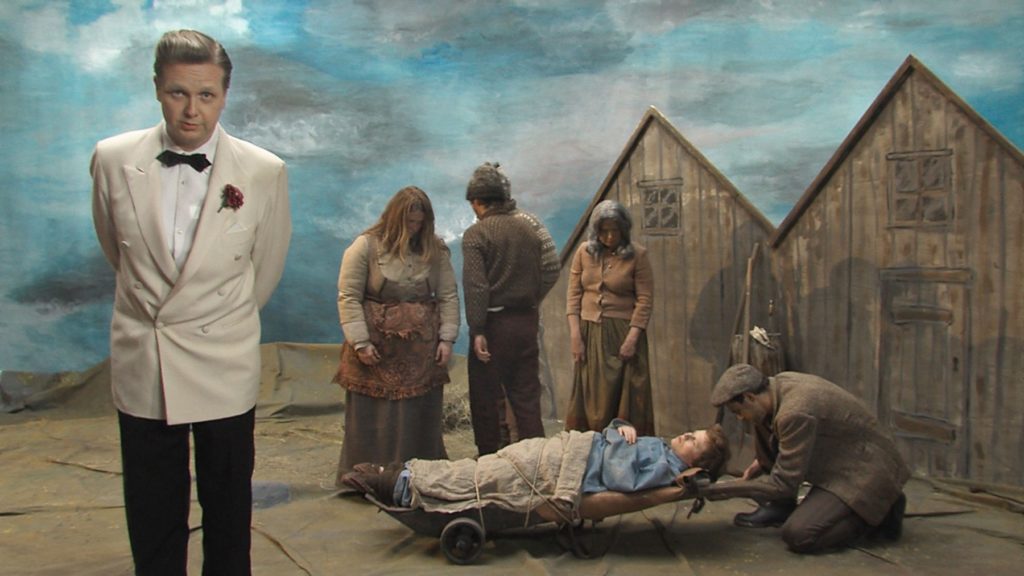
Ragnar Kjartansson, film still, World Light: The Life and Death of an Artist,2015, four-channel video; looped / duration: 8 hours 27 minutes 22 seconds.
Photo Courtesy Luhring Augustine.
4. Ragnar Kjartansson at Luhring Augustine, through December 22.
Among the most subtle of artists, yet with an outsize theatrical persona and sensibility, Ragnar Kjartansson once again delivers an astonishing New York gallery show. The two-venue extravaganza includes paintings, video pieces, and an epic film produced over the past two years. The New York exhibition coincides with a major survey of the Icelandic artist’s work at the Hirshhorn Museum and Sculpture Park in Washington, D.C.
Kjartansson’s peculiar brand of provocation appears in the group of paintings filling the main space in the gallery’s Chelsea branch, collectively titled Architecture and Morality (2016). The series of quasi-Impressionist paintings is populated with cartoonish cars but no figures. It turns out that these are renderings of Israeli homes located in contested areas of the West Bank. Under the auspices of the Center for Contemporary Art in Tel Aviv, the forty-year-old artist painted en plein air on site in the West Bank from morning until dusk for two weeks. At first the paintings appear rather sweet and innocuous. But after becoming aware of the politically loaded situation of the setting, they suddenly seem volatile and a bit foreboding.
Also in the Chelsea gallery, Scenes from Western Culture is a series of nine videos looped on medium-size monitors. Each piece presents an ordinary domestic scene with characters, but with no linear narrative. The most ambitious and mesmerizing work, World Light—The Life and Death of an Artist (2015), on view at the gallery’s Bushwick space, is a four-channel video based on an Iceland epic novel, and is epic in length—at over eight hours. Each of the four components, projected simultaneously, one on each wall of the gallery, tells a different narrative in this low-budget blockbuster that is at once a love story, sea adventure, village folk tale, and high-school pageant. With the artist appearing in one segment as a kind of M.C. in a white dinner jacket, the work is campy, absurd, hilarious, and disjointed. But, as always with Kjartansson’s work, it’s difficult to pull yourself away from it.

Installation view, Pamela Rosenkranz, “Anemine,” 2016.
Photo Courtesy Miguel Abreu Gallery.
5. Pamela Rosenkranz at Miguel Abreu, through December 22.
Central to Pamela Rozenkranz’s art is a merger of art and science, and a penchant for strange materials. The focus of her current exhibition is a dreamlike installation, Anemine, in which she uses just a few elements to conjure a jungle landscape, as well as some serious environmental issues. The Swiss artist offers an immersive experience in rooms filled with ethereal lighting in blue and green—evocative of vegetation, and water and sky—plus jungle sounds of screeching birds and other animals blasting from a number of—what else?—Amazon Echo speakers placed here and there on the gallery floor. Also on the floor are several small puddles of a mysterious liquid, Anemine, collected from slowly seeping hospital drip bags tucked high up in the gallery rafters.
Recommended: Musical Chairs Ensues as 207 Galleries Prepare for 2017 Armory Show
Representing Switzerland, Rosenkranz caused something of a sensation at the 2015 Venice Biennale with a similar, but smaller installation, plus a large pool filled with a gelatinous fluid concocted from unorthodox substances like silicone and liquid Viagra. The New York show is more cohesive and rewarding. Culled from the Amazon jungle, Anemine is another peculiar substance, also called “green blood,” that the 37-year-old artist has been researching for some time. According to the show’s press release, the liquid comes from worm-like annelids that inhabit the rain forest. One can imagine that a catastrophic impact on the ecosystem could occur if this fundamental jungle nutrient were to become endangered through pollution or in some other way. Rosenkranz used a synthesized version of Anemine as pigment in large abstract aluminum panel compositions that are also featured in the exhibition. Employing an elaborate conceptual approach that neatly balances the spare presentation, Rozenkranz has produced here a remarkable tour de force.
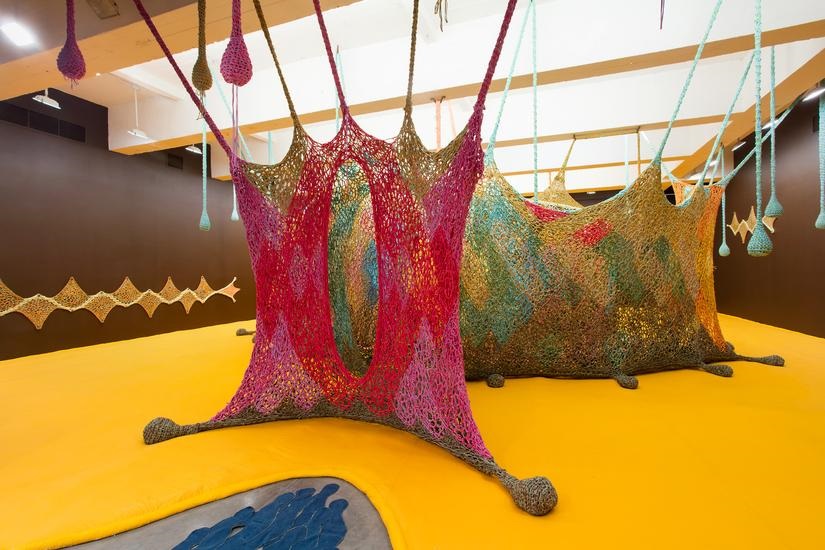
Installation view, Ernesto Neto, “The Serpent’s Energy Gave Birth to Humanity,” 2016.
Photo Courtesy Tanya Bonakdar Gallery.
6. Ernesto Neto at Tanya Bonakdar, through December 17.
Brazilian artist Ernesto Neto’s impassioned plea to preserve the Amazon rain forest takes the form in this show of an exploration of the rich cultural heritage and the vital ritual traditions of the Huni Kuin. The environment of this indigenous Amazon community, like so many others, is now endangered by the prospect of deregulated commercial enterprise. Neto’s resplendent, low-tech interactive exhibition, “The Serpent’s Energy Gave Birth to Humanity,” features in the street-level gallery a large-scale crocheted structure that visitors (removing shoes) are welcome to enter and peruse in a quiet, meditative circulation. The womb-like woven textile construction in neutral earth tones, ranging from deep red to yellow ocher, is soothing at the very least, and can be highly recommended as a transformative antidote to bouts of anxiety or despair.
Tall, tree-like crocheted green columns surround the heart of the core structure, a tent-like enclosure titled Adam Boa Eve Apple Egg. Filled with leaves and stones, the “trees” serve to balance the main edifice while they also reference the Brazilian Neo Concrete Movement, as well as Tropicália, the 1967 avant-garde movement—named after an installation by the late Rio-based artist-guru Hélio Oiticica—that called for a cultural revolution to counter the oppressive dictatorship in Brazil at the time. To all of these traditions Neto adds something fresh and invigorating.
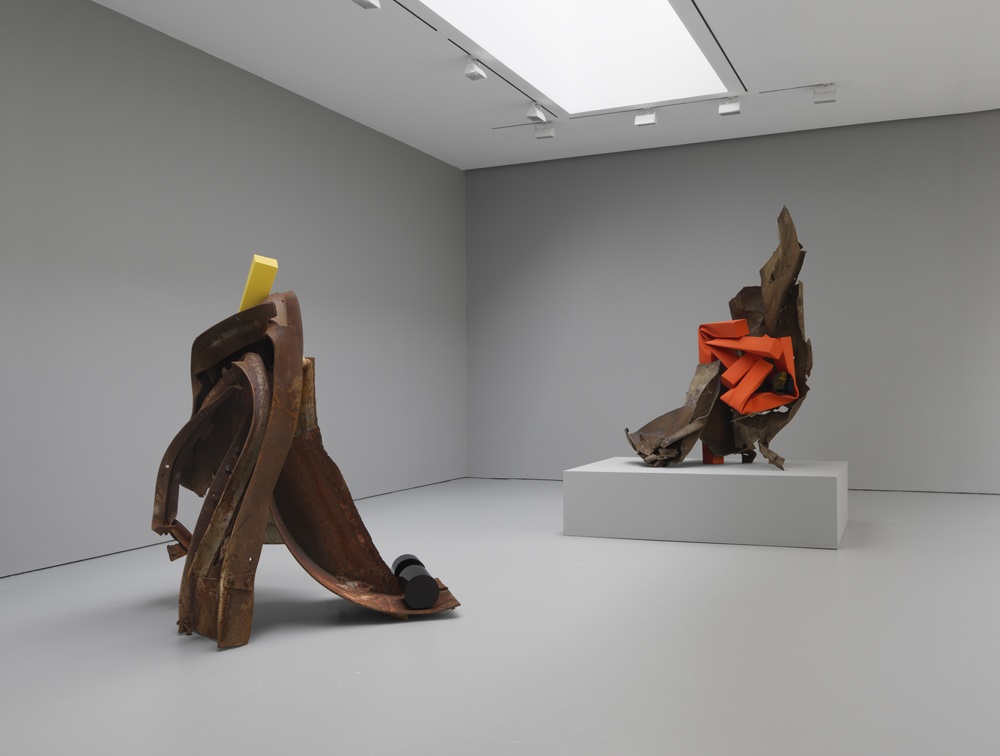
Installation view, Carol Bove, “Polka Dots,” 2016.
Photo Courtesy David Zwirner.
7. Carol Bove at David Zwirner, through December 17.
Carol Bove has long been preoccupied with space and spatial relationships in her multifaceted works, often using ephemeral materials. Lately, she has tackled the unlikely medium of large-scale, freestanding abstract welded-steel sculptures, and the result is this elegant and outlandish show, “Polka Dots.” The title refers to cylindrical steel forms painted black, which are incorporated into many of the works. The most macho of artistic practices, the medium of large-scale, welded steel is rarely utilized by women artists with such panache. Louise Nevelson and a few others have accomplished the feat in the past, but today Bove, born in Geneva in 1971 to American parents, and now a Brooklyn resident, may have the field all to herself.
What would Clement Greenberg, the late champion of Abstract Expressionist painting and sculpture, say about “Polka Dots”? Inspired by de Kooning’s 1953 painting Woman and Bicycle, Bove, like David Smith in his late work, adds color to her muscular compositions, such as Mouse Hole and The Bicycle. With its twisted beams resembling thrusting red limbs, Daphne and Apollo indeed suggests moving figures as in a Bernini marble. Bove seems to successfully channel John Chamberlain in some of her more Baroque compositions, including Hylomorph I. But in most of these new works Bove combines the graceful nuance of Anthony Caro with the aggression of Mark di Suvero, and other artistic forebearers, to come up with something entirely her own. Whether or not she is singlehandedly reviving formalist abstract sculpture for the 21st century remains to be seen. But for the moment, she offers an exciting challenge—to herself as well as to her audience.
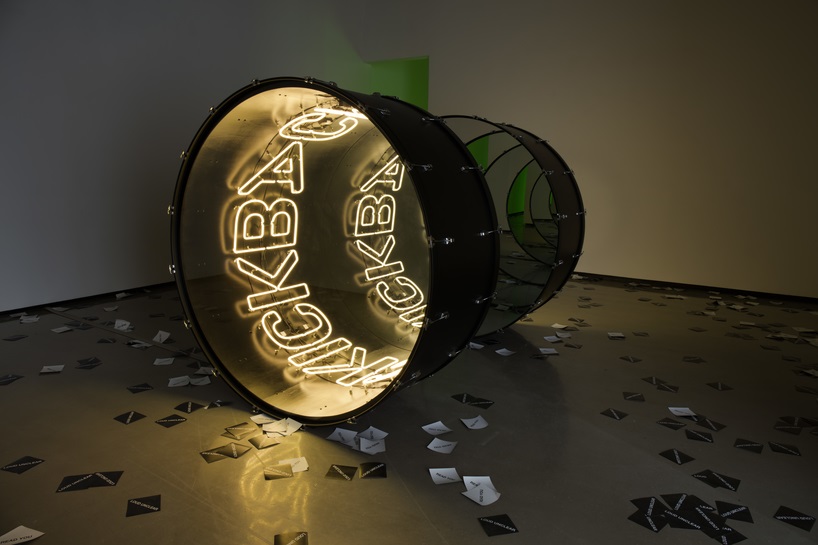
Installation view, Iván Navarro, “Mute Parade,” 2016.
Photo Courtesy Paul Kasmin Gallery.
8. Iván Navarro at Paul Kasmin Gallery, through December 23.
A dear colleague of mine referred to “Mute Parade,” an exhibition of Iván Navarro’s recent works, as “art-world bling.” Displayed in a darkened gallery, they are, indeed, brilliant, literally glowing, seductive objects. Navarro’s clever constructions, however, with neon tubing and mirrors creating an infinitely echoing void, spark the imagination as they trick the eye. The works bear a conceptual depth that offsets or enhances their inherent theatricality. Born in Santiago, Chile, and growing up during the oppressive Pinochet dictatorship, Navarro lived through nightly black-outs that were used strategically by the regime to keep the population indoors at night, and under control. It triggered in him a lifelong interest in electricity and its potential as a subversive tool.
Navarro produced his first mirror work in 2004. He was partly inspired by a legendary 1970 installation by Gordon Matta-Clark, in which a mirror placed on the floor of a Santiago museum reflected the sky, visible from a hole he had cut through ceiling. Navarro’s recent works in “Mute Parade” are discrete sculptures, and silent, but the installation constitutes a concert of sorts. Here, large drum-like cylindrical constructions contain neon signage referring to sound: Tone, Tune, Bass, Knockknockknock, etc. In some way his endeavor corresponds to Christian Marclay’s recent attempts to create a visual lexicon of sounds. Navarro scattered on the gallery floor paper squares with printed slogans, “Loud Unclear,” and “Read You.” From a distance they resemble confetti or ticker-tape left on the ground after a parade has passed by.
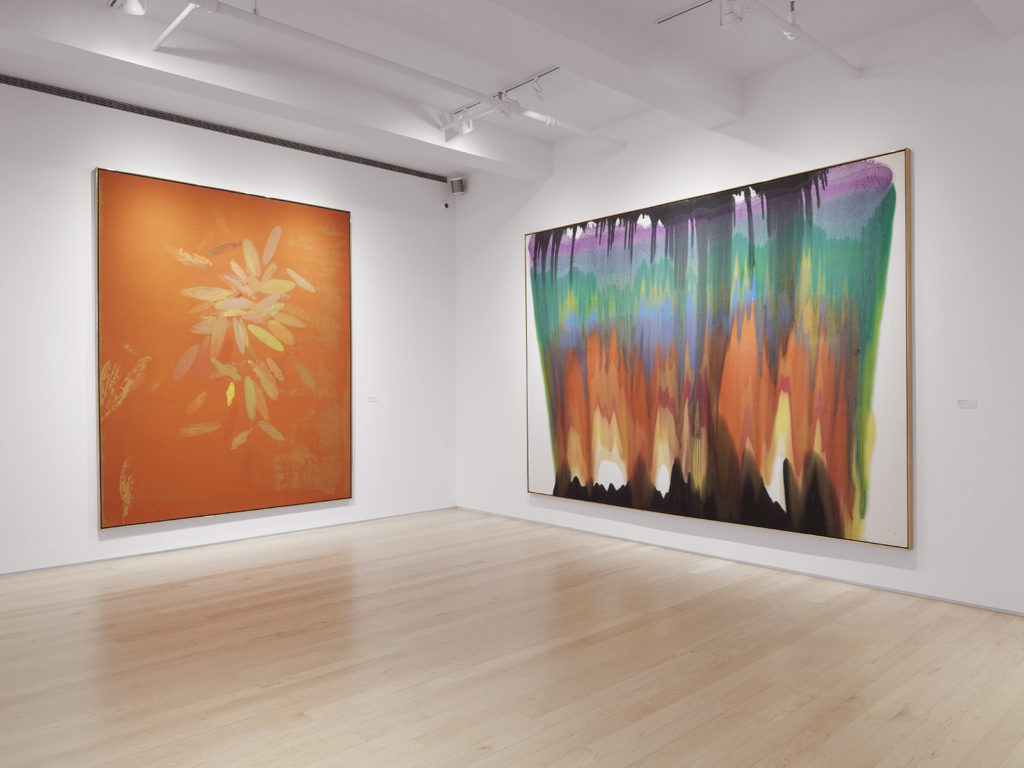
Installation view, “Helen Frankenthaler + L.M.N.O.P,” showing, left to right, Larry Poons, English Fields, 1968; Morris Louis, Saf Gimel, 1959. Photo Courtesy Yares Art Projects New York. .
9. Yares Art Projects inaugural New York exhibition, through January 15, 2017.
The newest addition to New York’s midtown gallery district is Yares Art Projects, a branch of the venerable Santa Fe gallery specializing in blue-chip, postwar classics by Joan Mitchell, Hans Hofmann, Milton Avery, Frank Stella, and many others. The gallery’s inaugural New York show, “Helen Frankenthaler and L.M.N.O.P,” refers to Morris Louis, Robert Motherwell, Kenneth Noland, Jules Olitski, and Larry Poons. The exhibition contains some of the best works these artists created in their formidable careers. It is a breathtaking group show that nearly swept away, at least for moment, my post-election blues.
A rarity in New York, the exhibition is a concise overview of the Color Field movement of the late 1950s and ’60s, whose heroic scaled canvases and immersive, panoramic viewing experiences are little known by younger generations of artists and art-lovers. Even though the genre is enjoying a revival lately, there seems to be simply not enough room in the city’s museums and galleries to show these sprawling works. Here, at the gallery entrance, Frankenthaler’s exuberant canvas First Blizzard (1957) starts off the proceedings, gracefully demonstrating how she bridged the gap between Abstract Expressionism and Color Field painting. Poons’s monumental flickering dots composition, Little Sangre de Cristro (1964), offers viewers a real retinal workout, while Louis’s Saf Gimel (1959), with its sumptuous veils of color, quiets the nerves and soothes the soul.

Mark Rothko, Untitled (Rust, Blacks on Plum), 1962.
© 1998 Kate Rothko Prizel & Christopher Rothko / Artists Rights Society (ARS), New York Photo courtesy The Mark Rothko Foundation and Pace Gallery.
10. Mark Rothko at Pace, through January 7, 2017.
Color Field, and a great many more recent forms of abstract painting, would have been unimaginable without the example and leadership of Mark Rothko (1903-1970). A hero to many, the Abstract Expressionist pioneer advanced the cause of painting as few have ever done. His personal life was not so heroic, however. Prone to melancholy and depression over the years, he eventually took his own life. For that reason, many observers regard his late and final works as dark and brooding reflections of his depressed mental state. Contradicting that popular misconception, “Rothko: Dark Palette” is a revelatory, museum-quality show in many respects. It contains twenty-one major canvases from 1955 through the 1960s, including a fine example from the thwarted Seagram’s commission of 1959, and others that have never or rarely been publicly shown.
Though subdued, the paintings are full of light and life. Regarding the late works, Rothko’s son Christopher told me in an interview I conducted with him earlier this year, for Yale University Press online, that “It is important to know that they are not dark. The black is soft, almost charcoal, and the grays are quite varied. . . the brushwork is very vigorous. . . They are not about depression; they are full of determined energy.” All of his observations are confirmed by this show, which underscores the fact that even in Rothko’s darkest compositions there is always a glimmer of light and color discernible somewhere on the surface, or just below.
David Ebony is a contributing editor of Art in America and a longtime contributor to artnet.